This cold-process tallow soap recipe is made with pure tallow and coconut oil, creating the perfect soap bar to use for dry or sensitive skin.
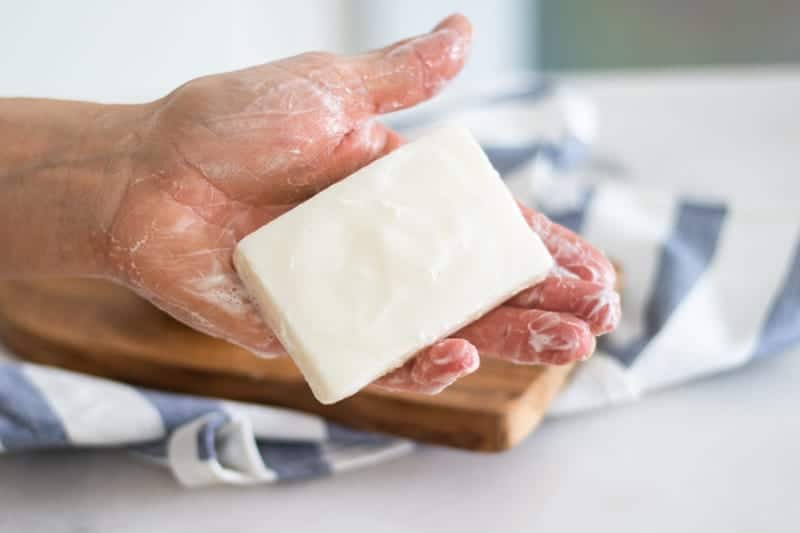
Making cold-process soap bars is not as hard as it seems. And this tallow soap recipe is no exception! The process is the same as any cold-process soap; it is just a matter of switching up the ingredients used.
Making your own soap is a great way to remove toxins from your home and save money. Your skin is the largest organ in your body and everything that gets put on it is absorbed into the bloodstream.
This is why it is so important to use natural skincare products. Once you get started making your own, you will realize it isn’t as hard as you might think. And fair warning, it gets addicting!
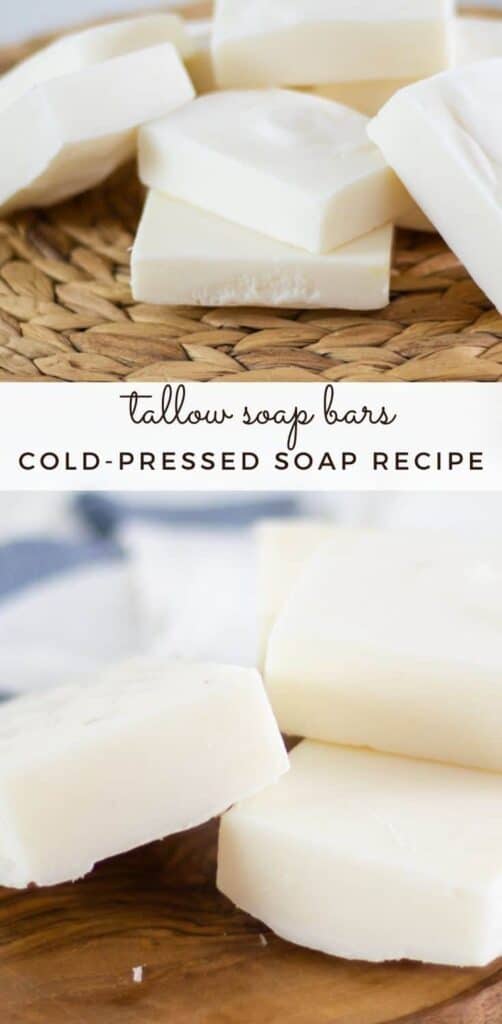
WHAT IS TALLOW?
Tallow is rendered fat. It can come from any animal but most commonly comes from beef fat. Like coconut oil, tallow is a liquid when in warm temperatures and solid in colder temperatures.
Rendered tallow can be used to make candles, body balms, lip balm, and even soap! Tallow is a great cooking fat too. It has a high smoke point making it a healthy option.
Beef tallow has a ton of benefits for the skin. It is full of vitamins A, D, K, E, & B12. Vitamin E is one of the best vitamins to promote healthy and clean skin.
WHY USE TALLOW IN SOAP BARS?

Tallow has been used in soap making for a very long time. Back in the day, before we had access to ordering any oil at the press of a button, tallow is what they used.
Homesteaders would render the tallow from cows or pigs and use it in soap making and cooking. If you have a farm, you can make this soap for free just from animal fat!
Tallow soap has a ton of great benefits for the skin, lathers well, gently cleanses the skin, and is very moisturizing.
WHAT DO I NEED TO MAKE SOAP WITH TALLOW?
All you need to make pure tallow soap bars is tallow, water, and lye. For this recipe, I am going to add coconut oil. I love using coconut oil for soap making as it is one of the most popular fats to add and is very nourishing for the skin.
This post contains affiliate links, which means I make a small commission at no extra cost to you. Get my full disclosure HERE.
TOOLS NEEDED TO MAKE COLD-PROCESS SOAP BARS
INGREDIENTS NEEDED TO MAKE TALLOW SOAP BARS
I used the Bramble Berry Calculator to get the exact measurements.
- 18 ounces beef tallow (60%)
- 12 ounces coconut oil (40%)
- 4.42 ounces of lye
- 9.89 ounces of water
(Makes approximately 12 bars)
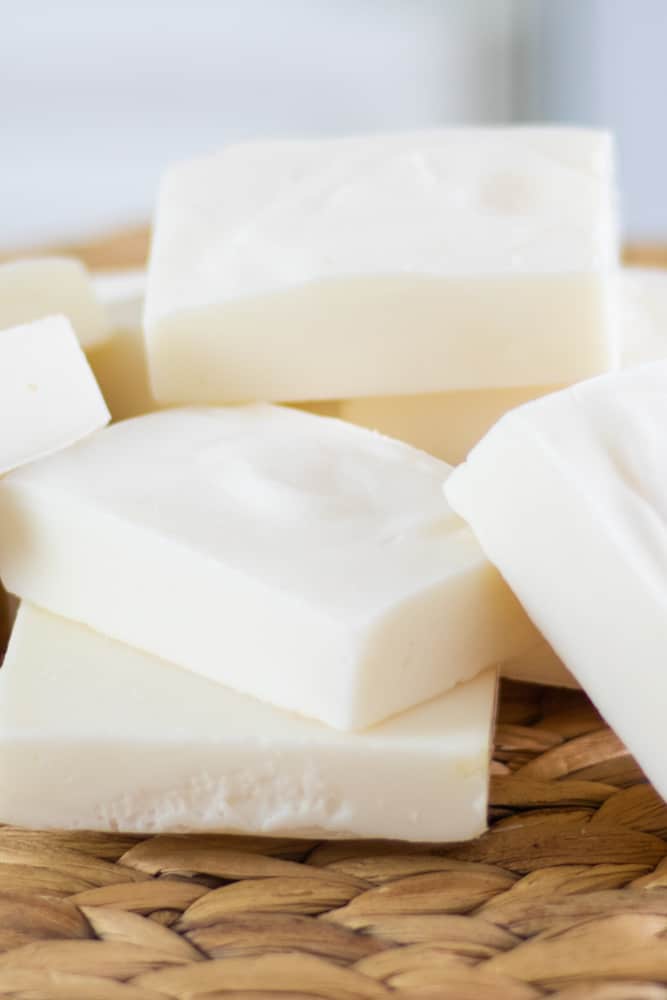
HOW TO MAKE TALLOW SOAP
- Using a digital scale, measure out your water and pour it into a heat-resistant glass. This is important because when you add in the lye, it will get very hot, very quick.
- Measure out the lye and add it to the water. Stir the lye until it dissolves. Note, the chemical reaction will cause it to heat up quickly.
- Measuring out the tallow and coconut oil, add them both to a saucepan. Melt over medium heat.
- Once the ingredients are melted, allow them to cool back down to 100 degrees. This may take a couple of hours.
- Once the fats reach 100 degrees, it is time to mix the lye water with the oils. Slowly add the lye and water to the oils, mix with an immersion blender. This will take a couple of minutes. You will know it is the right consistency when the soap from the blender drips and pools up at the top of the soap in the saucepan. This is known as the trace.
- If using essential oils or color, add those in now. Stir well.
- Pour the soap into the soap molds. If using silicone soap molds, you don’t have to do anything to them before pouring them in. Other molds may require parchment paper.
- Allow the soap to harden and sit in the molds for at least 24 hours or up to 3 days.
- Remove the soap from the molds and allow it to cure for 3-4 weeks before using.
RECIPE NOTES:
- Be sure to wear gloves, long sleeves, and eye protection when using lye. It is best to make soap in a well-ventilated area to avoid breathing in lye.
- When making soap, make sure there are no kids or pets around.
- The soap bars are safe once cured. A minimum of 3 weeks is recommended before using.
Learn more about making soap as a beginner here.
BENEFITS OF HOMEMADE SOAP BARS
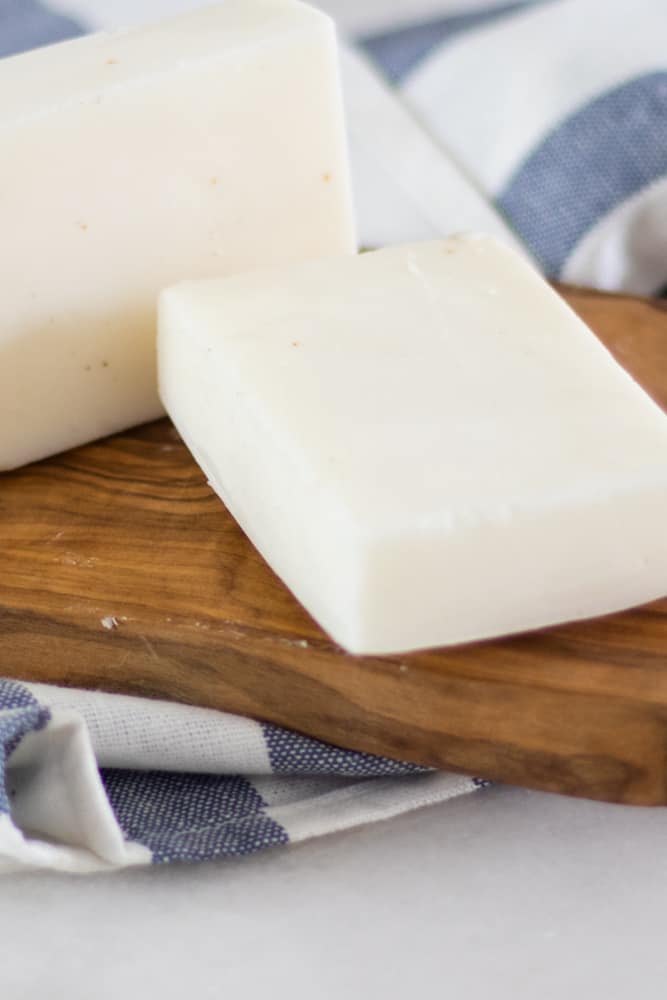
As mentioned above, making your own soap or any skincare, for that matter, is a great way to know exactly what you are putting on your skin. Using pure ingredients like coconut oil and tallow are the best for sensitive skin.
TALLOW
Tallow is commonly used in soap making because it makes a hard soap bar that lasts for a long time. You may be wondering about the smell as it is animal fat.
It does have a “fatty” smell, but it isn’t very strong. Once the bars are cured, they will pretty much have no animal fat scent.
COCONUT OIL
Coconut oil is the most popular fat to use in soap making. It protects the skin, is very moisturizing, and can reduce the signs of aging.
Coconut oil can be found in almost all of my skincare products and often times found in conventional skincare as well! It makes a great soap base.
If you want to make a pure tallow soap bar, you can leave the coconut oil out and adjust your measurements using a soap calculator.
ADDING IN ESSENTIAL OILS TO COLD-PROCESS SOAP BARS
Essential oils are a great way to customize the scent of your soap bars. Some of the best essential oils to use in soap making are lavender, frankincense, wild orange, chamomile, or peppermint.
If you choose to add in essential oils, you can add them into the mixture right before pouring the soap into the molds.
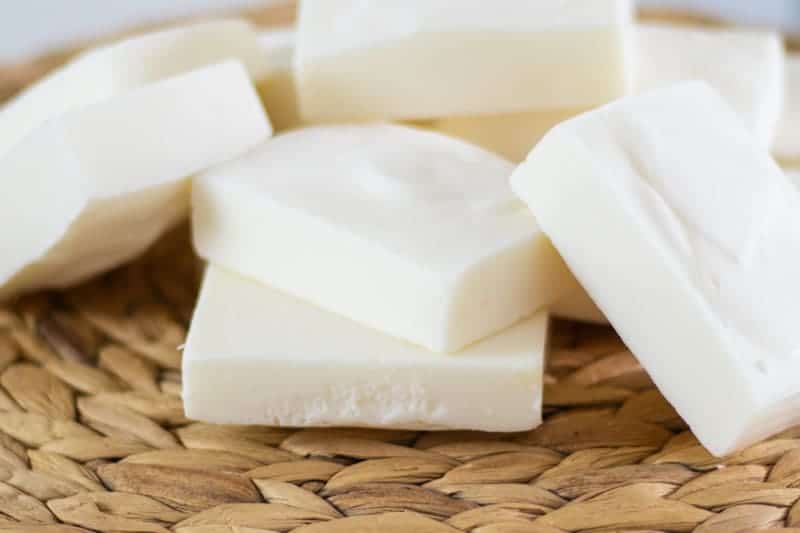
TIPS FOR COLD-PROCESS SOAP RECIPES
As daunting as it might sound, it is imperative that you measure your ingredients precisely. This is very easy to do if you have a digital kitchen scale.
When lye is mixed with fat, it makes soap. This process is called saponification. When the process is done correctly, there will be no lye in your final product.
Be sure to use an immersion or stick blender to get the correct trace. It will take much longer if doing this by hand!
You can use a variety of soap molds when making soap with tallow, but I highly recommend using silicone. They are the easiest molds to use and require no prep.

Cold-Process Tallow Soap
Equipment
- Kitchen thermometer
Ingredients
- 18 ounces of beef tallow
- 12 ounces of coconut oil
- 4.42 ounces lye
- 9.89 ounces of water
Instructions
- Using a digital scale, measure out your water and pour it into a heat-resistant glass. This is important because when you add in the lye, it will get very hot very quickly.
- Measure out the lye and add it to the water. Stir the lye until it dissolves. Note, the chemical reaction will cause it to heat up quickly.
- Measure out the tallow and coconut oil, add to a saucepan. Melt over medium heat.
- Once the ingredients are melted, allow them to cool back down to 100 degrees. This may take a couple of hours.
- Once the fats reach 100 degrees, it is time to mix the lye water with the oils. Slowly add the lye and water to the oils and mix with an immersion blender. This will take a couple of minutes. You will know it is the right consistency when the soap from the blender drips and pools up on top of the soap in the saucepan. This is known as the trace.
- If using essential oils or color, add those in now. Stir well.
- Pour the soap into the soap molds. If using silicone soap molds, you don’t have to do anything to them before adding the soap. Other molds may require parchment paper.
- Allow the soap to harden and sit in the molds for at least 24 hours or up to 3 days.
- Remove the soap from the molds and allow it to cure for 3-4 weeks before using.
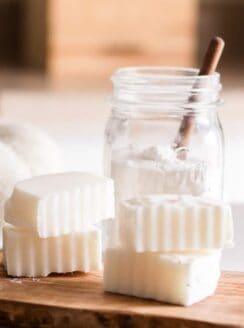
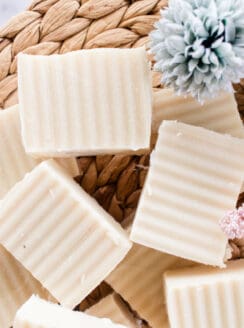
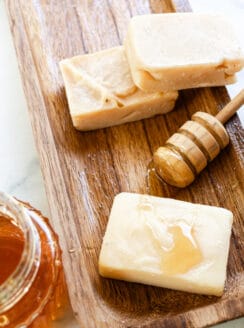
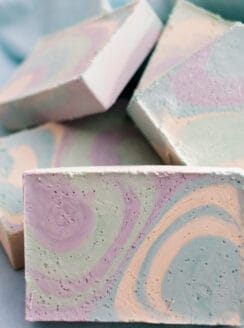
Sarah says
Can I use all tallow without the coconut oil and use cow or goat or donkey milk instead of water?
Laura says
To make adjustments to this recipe, you will need to use the soap calculator linked in the blog post.
Mary says
Hi Laura, Can you use a spoon instead of an immersion blender to mix the lye-water and oils? I only have one immersion blender that’s dedicated for food, and so wondered if a spoon would be ok as well.
Laura says
Yes, it can work by stirring with a spoon. It will however take quite a bit of time to come to trace.
Kristin Simmons says
For this recipe, how much essential oils could be used?
Diane says
Hello, do you have any bar soap or bar shampoo recipes without using lye?
Laura says
Hi Diane, I do have several melt-and-pour bar recipes in which the lye has already gone through the saponification process.
Search ‘melt and pour” in the search box.
Anne says
The measurements for the lye and water uses points. My scale doesn’t do that so I measure 4.4 for lye and 9.9 for water. Do you think that is okay?
Laura says
Just test it on your hands after it has cured. It should be fine!
Heather Hannan says
If I wanted to add rose hip oil to this would I just remove whatever amount I added from the coconut oil?
Laura says
You can use the soap calculater linked in the post to change the recipes and amounts.
Anne Hall says
Made this. Turned out beautiful and so easy!! Thank you for giving me the courage. ❤️
Laura says
I am so glad you made this and loved it!
Katelyn says
Hi Laura, do you use the same glass bowl and immersion blender as you do for food prep? I’ve heard varying opinions on lye usage. If I wash it will it leave any traces of lye? Or do I need a separate set of bowls, blender, and so on?
Laura says
It is best to use seperate!
Aisha says
The superfat in this recipe is 7% but how did you calculate the amount of water to be 9.89 oz. Please help me